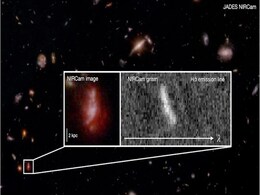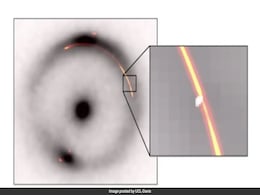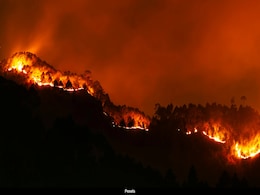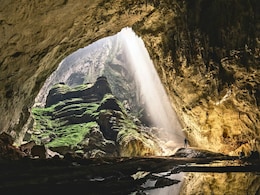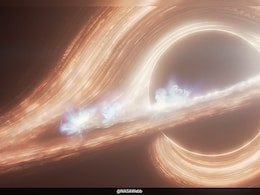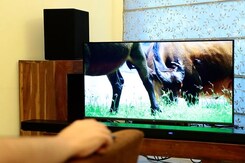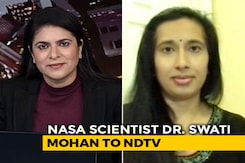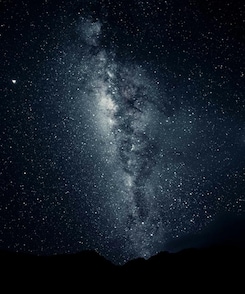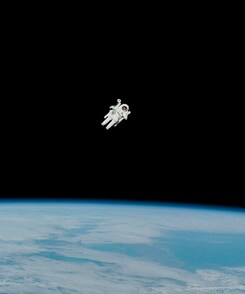Big Bang
- All
- News
- Videos
- Web Stories
-

James Webb Telescope Finds Evidence Of Giant "Dinosaur" Stars From Early Universe
- Tuesday December 16, 2025
- Science |
The research also suggests that these massive stars transformed directly into black holes at the end of their lives without undergoing a supernova explosion.
-
 www.ndtv.com
www.ndtv.com
-

New Gravitational-Wave Signal May Reveal Primordial Black Holes Born After the Big Bang
- Monday December 1, 2025
Scientists have spotted an unusual gravitational-wave signal that may reveal the universe’s first primordial black holes—tiny relics dating back to the Big Bang. Recorded by LIGO–Virgo–KAGRA in November 2025, the event involves an object far lighter than any known stellar remnant. If verified, it could reshape theories of black holes and da...
-
 www.gadgets360.com
www.gadgets360.com
-

NASA May Have Detected Oldest Stars In Universe Formed After Big Bang
- Friday November 21, 2025
- Feature |
NASA's James Webb Space Telescope may have detected the universe's oldest Population III stars in galaxy LAP1-B, 13 billion light-years away.
-
 www.ndtv.com
www.ndtv.com
-

James Webb Space Telescope May Have Spotted the Universe’s First Stars, Astronomers Say
- Wednesday November 19, 2025
Astronomers using the James Webb Space Telescope have detected a distant, metal-poor galaxy whose unusually massive, ultraviolet-bright stars match the expected signatures of Population III — the universe’s first stars. Through the help of gravitational lensing and Webb’s infrared sensitivity, researchers observed light from just 800 million ...
-
 www.gadgets360.com
www.gadgets360.com
-

How Hot Was the Universe 7 Billion Years Ago? Scientists Now Have an Answer
- Wednesday November 5, 2025
Japanese astronomers using ALMA data have found the universe was about twice as hot 7 billion years ago, with a temperature of 5.13 K compared to today’s 2.7 K. The finding aligns perfectly with Big Bang predictions that the Universe cools as it expands, providing the most precise mid-epoch measurement yet and reinforcing confidence in standard c...
-
 www.gadgets360.com
www.gadgets360.com
-

Keio University Team Measures Ancient Cosmic Temperature, Confirming Big Bang Prediction
- Tuesday November 4, 2025
Using ALMA, Keio University scientists measured a 5.13 K cosmic background temperature from 7 billion years ago—matching Big Bang predictions of universal cooling. This precise reading, based on quasar absorption data, is the most accurate at that epoch and offers strong confirmation of how the Universe’s temperature decreases over time.
-
 www.gadgets360.com
www.gadgets360.com
-

Ghostly Neutrinos May Hold the Answer to Why Matter Exists in Our Universe
- Monday November 3, 2025
In a breakthrough study, scientists merged data from Japan’s T2K and the U.S. NOvA neutrino experiments to explore why matter exists in the universe. The findings improve measurements of neutrino behavior and may help reveal whether these particles break symmetry with antimatter, offering vital clues to how the universe survived after the Big Ban...
-
 www.gadgets360.com
www.gadgets360.com
-

Kyunki Saas Bhi Kabhi Bahu Thi 2 Promo: Bill Gates Greets Smriti Irani's Tulsi With Jai Shri Krishna
- Thursday October 23, 2025
- Entertainment |
This marks Bill Gates' second-ever television appearance, following his cameo on The Big Bang Theory.
-
 www.ndtv.com/entertainment
www.ndtv.com/entertainment
-

James Webb Telescope Uncovers the Turbulent Birth of the First Galaxies
- Saturday October 25, 2025
Using JWST data, astronomers analyzed more than 250 galaxies from the universe’s first 1.5 billion years and found most were chaotic, with gas swirling in all directions. Only a few showed early signs of ordered rotation. The findings reveal how intense star formation and gravitational turbulence gave way to stability, transforming the early univ...
-
 www.gadgets360.com
www.gadgets360.com
-

Astronomers Spot Mysterious Dark Object In Distant Universe, It's A Million Times Larger Than The Sun
- Tuesday October 14, 2025
- Science |
A mysterious object with a mass equivalent to 1 million suns has been detected in space, but its nature remains unknown.
-
 www.ndtv.com
www.ndtv.com
-

Flipkart Diwali Sale 2025: Motorola Edge 60 Pro, Moto Razr 60 and More Go on Sale at Discounted Prices
- Monday October 13, 2025
Motorola has announced festive discounts on smartphones, tablets, TWS earbuds, and smart TVs. Handsets such as Motorola Edge 60 Pro, Edge 60 Fusion, Moto G86 Power, and more, can be purchased with lucrative discounts during the Flipkart Diwali sale. Further, offers on TWS earbuds, QLED TVs, and Mini LED TVs will be live during the second phase of t...
-
 www.gadgets360.com
www.gadgets360.com
-

Physicists Predict When Life On Earth Will End In A Reverse Big Bang
- Thursday October 9, 2025
- Science |
A new study predicts the Universe will stop expanding in 11 billion years and collapse in a "Big Crunch" around 20 billion years from now.
-
 www.ndtv.com
www.ndtv.com
-

Flipkart Diwali Sale 2025 Date Announced; Flipkart Black, Plus Members to Get Early Access
- Monday October 6, 2025
Flipkart Big Bang Diwali Sale will begin in India on October 11. Flipkart Plus and Black members will get early access to the sale. The online marketplace has partnered with SBI Card to offer instant discounts on eligible purchases. There will be exchange offers and no-cost EMI options as well. The end date of the sale is not confirmed yet.
-
 www.gadgets360.com
www.gadgets360.com
-

Scientists Predict 90% Chance Of Black Hole Explosion By 2035 That Could Reveal Universe's Secrets
- Saturday September 13, 2025
- Science |
The predicted explosion could be strong evidence of a theorised but never observed kind of black hole, called a "primordial black hole".
-
 www.ndtv.com
www.ndtv.com
-

James Webb Telescope Finds Evidence Of Giant "Dinosaur" Stars From Early Universe
- Tuesday December 16, 2025
- Science |
The research also suggests that these massive stars transformed directly into black holes at the end of their lives without undergoing a supernova explosion.
-
 www.ndtv.com
www.ndtv.com
-

New Gravitational-Wave Signal May Reveal Primordial Black Holes Born After the Big Bang
- Monday December 1, 2025
Scientists have spotted an unusual gravitational-wave signal that may reveal the universe’s first primordial black holes—tiny relics dating back to the Big Bang. Recorded by LIGO–Virgo–KAGRA in November 2025, the event involves an object far lighter than any known stellar remnant. If verified, it could reshape theories of black holes and da...
-
 www.gadgets360.com
www.gadgets360.com
-

NASA May Have Detected Oldest Stars In Universe Formed After Big Bang
- Friday November 21, 2025
- Feature |
NASA's James Webb Space Telescope may have detected the universe's oldest Population III stars in galaxy LAP1-B, 13 billion light-years away.
-
 www.ndtv.com
www.ndtv.com
-

James Webb Space Telescope May Have Spotted the Universe’s First Stars, Astronomers Say
- Wednesday November 19, 2025
Astronomers using the James Webb Space Telescope have detected a distant, metal-poor galaxy whose unusually massive, ultraviolet-bright stars match the expected signatures of Population III — the universe’s first stars. Through the help of gravitational lensing and Webb’s infrared sensitivity, researchers observed light from just 800 million ...
-
 www.gadgets360.com
www.gadgets360.com
-

How Hot Was the Universe 7 Billion Years Ago? Scientists Now Have an Answer
- Wednesday November 5, 2025
Japanese astronomers using ALMA data have found the universe was about twice as hot 7 billion years ago, with a temperature of 5.13 K compared to today’s 2.7 K. The finding aligns perfectly with Big Bang predictions that the Universe cools as it expands, providing the most precise mid-epoch measurement yet and reinforcing confidence in standard c...
-
 www.gadgets360.com
www.gadgets360.com
-

Keio University Team Measures Ancient Cosmic Temperature, Confirming Big Bang Prediction
- Tuesday November 4, 2025
Using ALMA, Keio University scientists measured a 5.13 K cosmic background temperature from 7 billion years ago—matching Big Bang predictions of universal cooling. This precise reading, based on quasar absorption data, is the most accurate at that epoch and offers strong confirmation of how the Universe’s temperature decreases over time.
-
 www.gadgets360.com
www.gadgets360.com
-

Ghostly Neutrinos May Hold the Answer to Why Matter Exists in Our Universe
- Monday November 3, 2025
In a breakthrough study, scientists merged data from Japan’s T2K and the U.S. NOvA neutrino experiments to explore why matter exists in the universe. The findings improve measurements of neutrino behavior and may help reveal whether these particles break symmetry with antimatter, offering vital clues to how the universe survived after the Big Ban...
-
 www.gadgets360.com
www.gadgets360.com
-

Kyunki Saas Bhi Kabhi Bahu Thi 2 Promo: Bill Gates Greets Smriti Irani's Tulsi With Jai Shri Krishna
- Thursday October 23, 2025
- Entertainment |
This marks Bill Gates' second-ever television appearance, following his cameo on The Big Bang Theory.
-
 www.ndtv.com/entertainment
www.ndtv.com/entertainment
-

James Webb Telescope Uncovers the Turbulent Birth of the First Galaxies
- Saturday October 25, 2025
Using JWST data, astronomers analyzed more than 250 galaxies from the universe’s first 1.5 billion years and found most were chaotic, with gas swirling in all directions. Only a few showed early signs of ordered rotation. The findings reveal how intense star formation and gravitational turbulence gave way to stability, transforming the early univ...
-
 www.gadgets360.com
www.gadgets360.com
-

Astronomers Spot Mysterious Dark Object In Distant Universe, It's A Million Times Larger Than The Sun
- Tuesday October 14, 2025
- Science |
A mysterious object with a mass equivalent to 1 million suns has been detected in space, but its nature remains unknown.
-
 www.ndtv.com
www.ndtv.com
-

Flipkart Diwali Sale 2025: Motorola Edge 60 Pro, Moto Razr 60 and More Go on Sale at Discounted Prices
- Monday October 13, 2025
Motorola has announced festive discounts on smartphones, tablets, TWS earbuds, and smart TVs. Handsets such as Motorola Edge 60 Pro, Edge 60 Fusion, Moto G86 Power, and more, can be purchased with lucrative discounts during the Flipkart Diwali sale. Further, offers on TWS earbuds, QLED TVs, and Mini LED TVs will be live during the second phase of t...
-
 www.gadgets360.com
www.gadgets360.com
-

Physicists Predict When Life On Earth Will End In A Reverse Big Bang
- Thursday October 9, 2025
- Science |
A new study predicts the Universe will stop expanding in 11 billion years and collapse in a "Big Crunch" around 20 billion years from now.
-
 www.ndtv.com
www.ndtv.com
-

Flipkart Diwali Sale 2025 Date Announced; Flipkart Black, Plus Members to Get Early Access
- Monday October 6, 2025
Flipkart Big Bang Diwali Sale will begin in India on October 11. Flipkart Plus and Black members will get early access to the sale. The online marketplace has partnered with SBI Card to offer instant discounts on eligible purchases. There will be exchange offers and no-cost EMI options as well. The end date of the sale is not confirmed yet.
-
 www.gadgets360.com
www.gadgets360.com
-

Scientists Predict 90% Chance Of Black Hole Explosion By 2035 That Could Reveal Universe's Secrets
- Saturday September 13, 2025
- Science |
The predicted explosion could be strong evidence of a theorised but never observed kind of black hole, called a "primordial black hole".
-
 www.ndtv.com
www.ndtv.com









